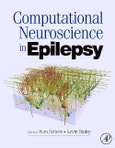Epilepsy is a neurological disorder that affects millions of patients worldwide and arises from the concurrent action of multiple pathophysiological processes. The power of mathematical analysis and computational modeling is increasingly utilized in basic and clinical epilepsy research to better understand the relative importance of the multi-faceted, seizure-related changes taking place in the brain during an epileptic seizure. This groundbreaking book is designed to synthesize the current ideas and future directions of the emerging discipline of computational epilepsy research. Chapters address relevant basic questions (e.g., neuronal gain control) as well as long-standing, critically important clinical challenges (e.g., seizure prediction). Computational Neuroscience in Epilepsy should be of high interest to a wide range of readers, including undergraduate and graduate students, postdoctoral fellows and faculty working in the fields of basic or clinical neuroscience, epilepsy research, computational modeling and bioengineering.
Please Note: This is an On Demand product, delivery may take up to 11 working days after payment has been received.
Table of Contents
ContributorsForeword
Rise of the Machines On the Threshold of a New Era in Epilepsy Research
Introduction: Applications and Emerging Concepts of Computational
Neuroscience in Epilepsy Research
Part I Computational Modeling Techniques and Databases in Epilepsy Research
1 Simulation of Large Networks: Technique and Progress
2 The Neuron Simulation Environment in Epilepsy Research
3 The CoCoDat Database: Systematically Organizing and Selecting Quantitative Data on Single Neurons and Microcircuitry
4 Validating Models of Epilepsy
5 Using NeuroConstruct to Develop and Modify Biologically Detailed 3D Neuronal Network Models in Health and Disease
6 Computational Neuroanatomy of the Rat Hippocampus: Implications and Applications to Epilepsy
Part II Epilepsy and Altered Network Topology
7 Modeling Circuit Alterations in Epilepsy: A Focus on Mossy Cell Loss and Mossy Fiber Sprouting in the Dentate Gyrus
8 Functional Consequences of Transformed Network Topology in Hippocampal Sclerosis
9 Multiple-Scale Hierarchical Connectivity of Cortical Networks Limits the Spread of Activity
Part III Destabilization of Neuronal Networks
10 Computer Simulations of Sodium Channel Mutations that Cause Generalized Epilepsy with Febrile Seizures Plus
11 Gain Modulation and Stability in Neural Networks
12 Neocortical Epileptiform Activity in Neuronal Models with Biophysically Realistic Ion Channels
13 Corticothalamic Feedback: A Key to Explain Absence Seizures
14 Mechanisms of Graded Persistent Activity: Implications for Epilepsy
15 Small Networks, Large Networks, Experiment and Theory Can We Bring Them Together with Oscillations, Heterogeneity and Inhibition?
Part IV Homeostasis and Epilepsy
16 Stability and Plasticity in Neuronal and Network Dynamics
17 Homeostatic Plasticity and Post-Traumatic Epileptogenesis
Part V Mechanisms of Synchronization
18 Synchronization in Hybrid Neuronal Networks
19 Complex Synaptic Dynamics of GABAergic Networks of the Hippocampus
20 Experimental and Theoretical Analyses of Synchrony in Feedforward Networks
21 Modulation of Synchrony by Interneurons: Insights from Attentional Modulation of Responses in the Visual Cortex
Part VI Interictal to Ictal Transitions
22 Cellular and Network Mechanisms of Oscillations Preceding and Perhaps Initiating Epileptic Discharges
23 Transition to Ictal Activity in Temporal Lobe Epilepsy: Insights from Macroscopic Models
24 Unified Modeling and Analysis of Primary Generalized Seizures
25 A Neuronal Network Model of Corticothalamic Oscillations: The Emergence of Epileptiform Absence Seizures
26 Extracellular Potassium Dynamics and Epileptogenesis
27 Slow Waves Associated with Seizure Activity
Part VII Seizure Dynamics
28 Dynamics of Epileptic Seizures during Evolution and Propagation
29 Are Correlation Dimension and Lyapunov Exponents Useful Tools for Prediction of Epileptic Seizures?
30 Towards a Dynamics of Seizure Mechanics
Part VIII Towards Computer-Aided Therapy
31 Principles and Practice of Computer-Aided Drug Design as Applied to the Discovery of Antiepileptic Agents
32 Computation Applied to Clinical Epilepsy and Antiepileptic Devices
33 Microelectrode-based Epilepsy Therapy: A Hybrid Neural Prosthesis Incorporating Seizure Prediction and Intervention with Biomimetic Maintenance of Normal Hippocampal Function
Index








